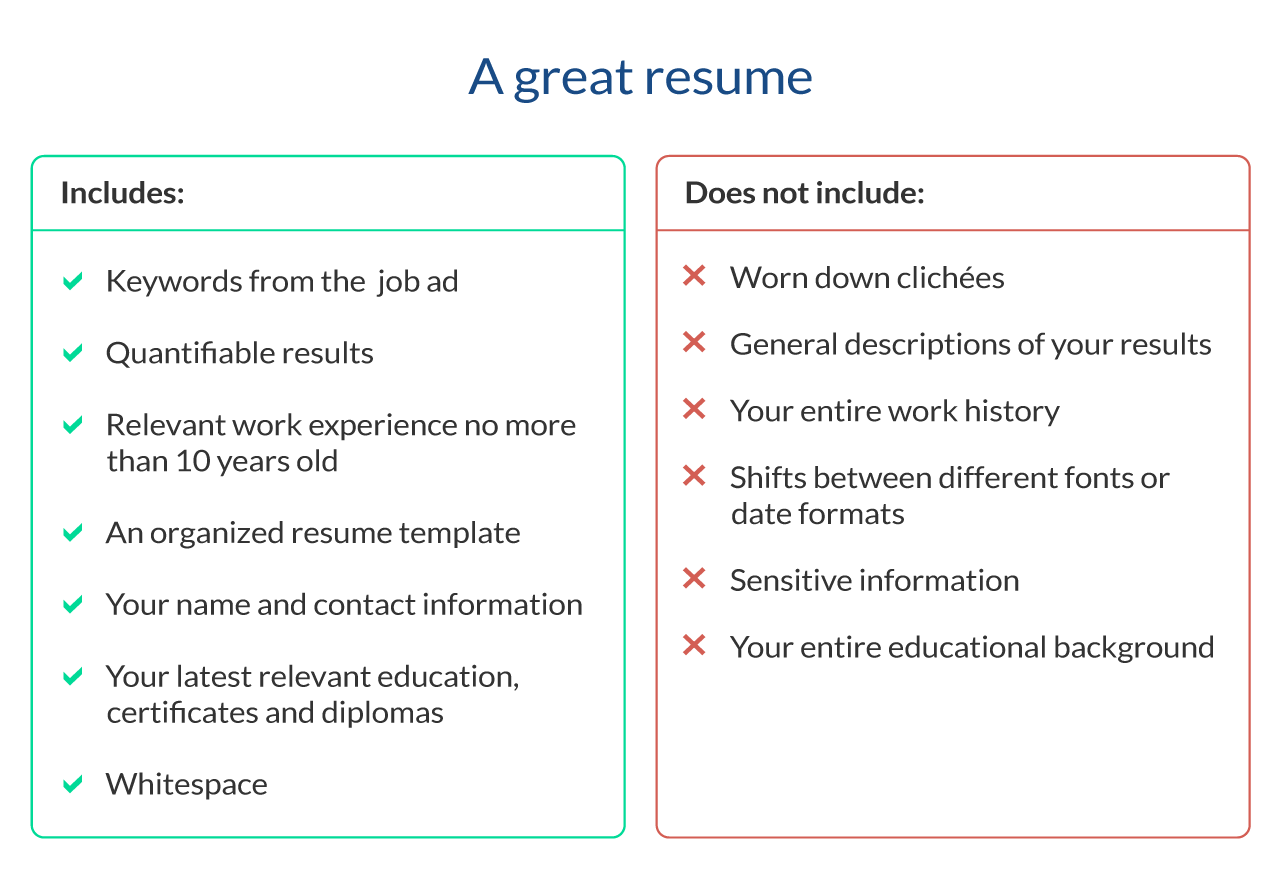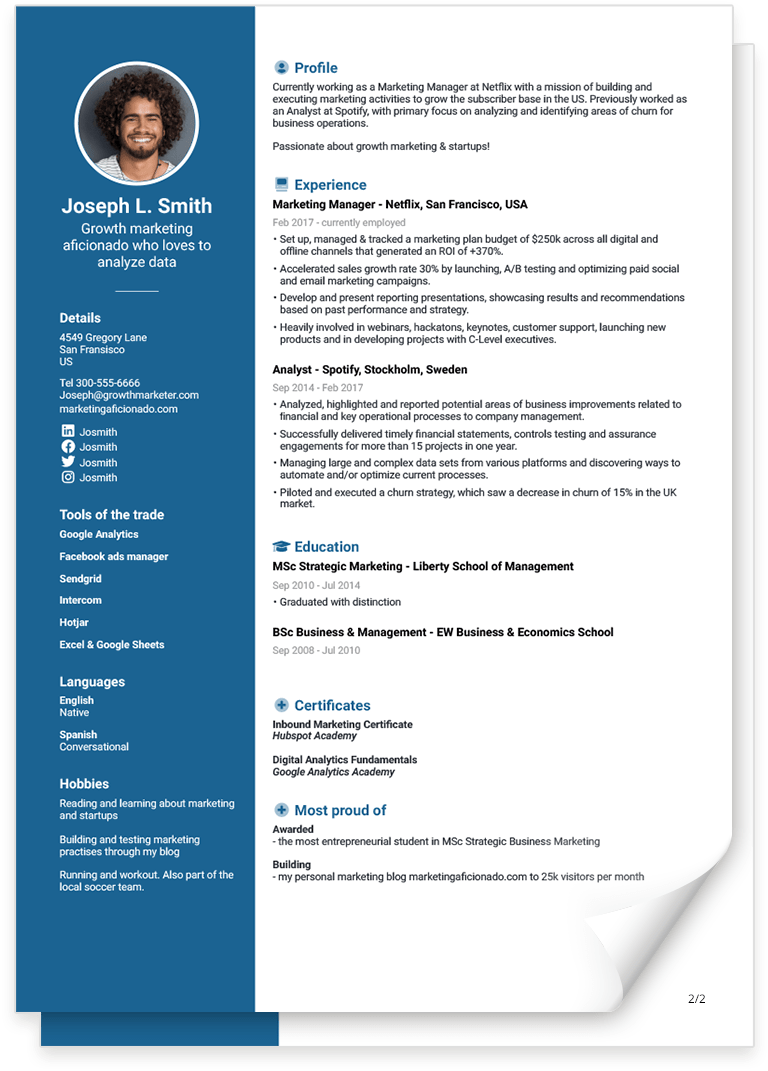How To Write a Resume - The Ultimate Guide [2025]
![How To Write a Resume - The Ultimate Guide [2025]](https://jofibostorage.blob.core.windows.net/blog/how-to-write-a-resume-header.png)
For most job seekers a great resume is the gateway to their dream job. But how do you write a great resume? We’ll look into just that in this article. We will show you a step by step guide on how to write a resume for a job. We will also give you lots of actionable tips and tricks that you can use straight away. Finally, we are going to show you examples plus resume dos and don’ts.
(If you're from the UK you might be looking for a guide on how to write a CV instead).
So read on to learn more about:
- The basics - what is a resume?
- How to write a resume for a job you want - a step by step guide
- Which resume formats there are and which you should choose
- How much/how little you should include in your resume
- Dos and don’ts for writing your resume
Are you instead looking for a guide on how to use AI for your resume?
What is a resume? The basics
A resume, or a CV as it is called outside of the US, is the most important document in your career. It is a brief but informative summary of your professional experiences and achievements during your work life. It is (usually) a required part of applying for jobs. Think of it as a marketing document, where you are the product. Its sole purpose is to get you through the door and into a job interview.
You should always keep your resume as clear and concise as possible. Ideally, it should be only one to three pages long. In other words, keep it simple.
How to write a resume for a job you want - a step by step guide
Writing a resume is kind of like following a recipe. There are variations for how to do it but the end-goal is the same: to land job interviews and get hired. Below is a clear and short step by step guide to write a resume. Each step will be explained in detail with tips and tricks. You can click on each individual step you want to read about.
- Choose your resume format
- Write your resume headline (customize it to the job ad)
- Add your contact information
- Write a short and catchy resume summary (customize it to the job ad)
- Add all your relevant work experience in a reverse chronological order (meaning you list your most recent job in the beginning of your resume)
- Make sure to use power words and correct key words
- Add your latest education (keep it at max. two levels)
- Add your skills to your resume (customize them to the job ad)
- Optional: Relevant additional sections such as volunteer work
- Proofread

1. Choose the right resume format
When it comes to deciding on which resume format you should go for, there are a few options. Which one you should choose depends on your situation. The three resume formats are:
- The reverse chronological resume format: This is by far the most popular resume format and the one employers are most familiar with. Choose this format if you have extensive relevant work experience.
- The functional (skill based) resume format: This resume format is ideal if you’re making a career or job change or if you lack relevant work experience.
- The hybrid (combination) resume format: With this resume format you get the best from each world. Choose this format if you have relevant skills but no extensive work experience yet.

In most situations you should go for the reverse-chronological resume format since this is the resume format that most clearly shows how your career has progressed over time. For that reason this guide will be focused on a resume with this format.
2. Resume headline
Your resume’s headline consists of your name and your professional title. When you write your headline you should use the job title from the job ad. Add a little bit of extra pazazz by including some details about you. For example: Senior Account Manager with Focus on Growth and Performance.
Some larger companies use applicant tracking systems. By being strategic with your professional titles you maximize your chances of them recognizing you as a strong candidate. For example, if the company is looking for a Marketing Manager, but your previous title was Marketing Executive, you write Marketing Manager.
When it comes to your job titles for describing your previous work history, you should also stop and consider them a moment. A lot of companies use their own more or less self-invented job titles, which in itself is fine. A company that uses the word Ninja in their job titles (like Accounting Ninja = Financial Manager) is probably a lot of fun to work at. But on a resume you’ll want both the ATS and the recruiter to recognize your job titles. Therefore, if your previous title was Accounting Ninja simply write Financial Manager. It’s not as sexy but it’ll get the job done.
3. Contact information
You now know how to choose the right resume format and what to write as a headline. You’re well on your way to create an awesome resume. Next up is your contact information.
Your contact information should be below your resume’s headline. You should include the following:
- Email address (make sure it’s appropriate and professional)
- Phone number
- Physical location (zip code, city, country is often enough)
- If you have a personal website like an online portfolio this is also where you should place it
It’s also an option to add your social media accounts such as LinkedIn but keep in mind that you invite the recruiter to look at them. So be sure that all your social media content is sober if you choose to add your profiles to your resume. We recommend only adding your LinkedIn profile here.
4. Resume summary
A strong resume summary, or profile, will definitely set you apart from your competitors. The resume summary is a brief description of you and your qualifications in relation to the job you’re applying for. Therefore it’s critical that you target the right keywords from the job ad to make sure you grab the recruiter’s attention.
If it’s been more than 10 years since you last wrote a resume, you might know this part as a resume objective. However, an objective could make your resume appear a bit old fashioned which is why we recommend you use a resume summary, or resume profile.
You will want to keep the summary short and sweet. About 50 words or even less. Think quality over quantity.
For example:
“Bilingual, creative, patient and dependable kindergarten teacher with more than 4 years of experience teaching 5-6 year olds. Committed to providing students with necessary tools to achieve academic goals.”
5. Relevant work experience
Your work experience section is the most important part of your resume because this is where you show your qualifications for the job.
While it may be tempting to add all of your previous work history, don’t. The key here is the word “relevant”. When you add your work experience to your resume make sure you only include the relevant experiences. And don’t go back more than 10 years. It’s better to have a few relevant professional experiences than a tangle of odd jobs here and there with no relevance to the job you’re applying for.
To make sure your resume is both logical and informative you will want to list your work experience in a reverse-chronological order. This means you need to add your most recent at the top and work your way backwards to your least recent at the bottom.
For each work experience you add to your resume make sure you’ve optimized it as much as possible for the job ad. That means you need to use the same terms as in the job ad wherever possible - eg. professional title.
When you describe your previous work experiences it’s an advantage to use bullets to highlight your results and achievements. Hiring managers love this. If you have any quantifiable results make sure you use them as much as possible. This will make your resume much easier to read.
Build each work experience using this formula:
- Your title
- Company name
- Company location (city and state)
- Dates of employment (month and year)
If you’re still currently working at a company, you can simply write “[month], [year]–present” for the employment dates.
(When you use a resume builder like Jofibo this is automatically formatted for you so you don’t have to worry about keeping it neat).
Include about 3–5 bullet points of your main duties and achievements working in that role with this formula:
- Start your bullet point with an action verb
- Add a quantifiable point
- Mention a specific and relevant job duty
Like this:
- Created lesson plans and prepared 90+ students for quizzes and exams
- Taught 3 classes where 95% of students passed their exams with a minimum of 2.9 GPA
To create an even better work experience section it may be a good idea to check out the STAR method. With this method you can easily structure your work experience in a way that lets the employer know exactly how you can contribute value to the company.
Don’t have a lot of work experience yet? Don’t worry; check out how to write a resume with no experience.
6. Power words and keywords
By now there should be no doubt that you need to tailor your resume to each job ad. One way of doing this is by making sure you align your terms with the terms used in the job ad. Thoroughly read the job ad and highlight the experiences and skills that the company is looking for. Make sure you use them in the description of you, your skills, and work experience.
Also make sure you add power words to your resume. Power words and action verbs have a great effect on the people reading your resume. They will make you seem even more competent and professional and will make your resume come alive. As with everything else though, don’t overdo it.
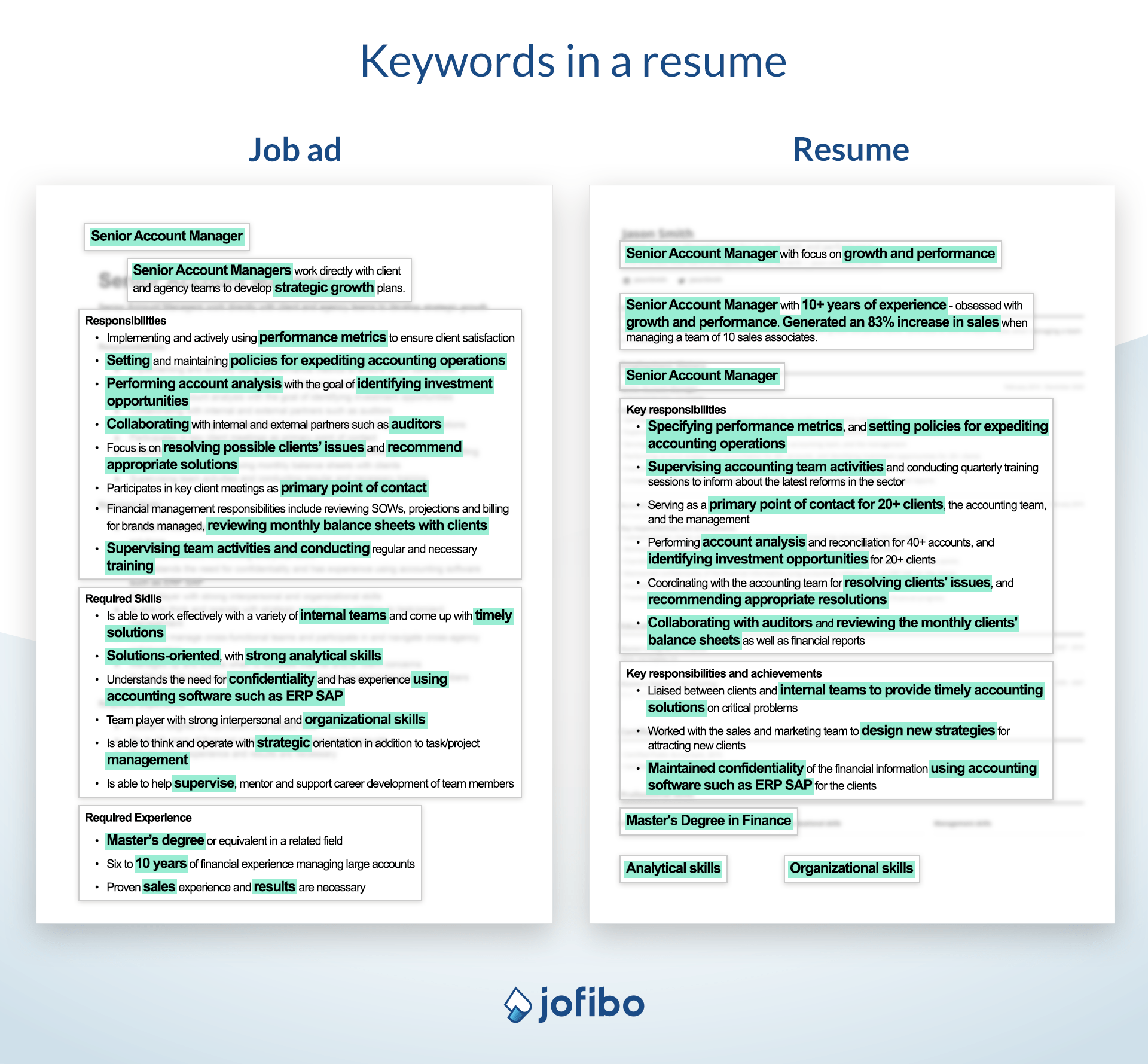
7. Relevant education
Adding your education to your resume is a vital way to show your potential employer that you have the necessary knowledge to maintain the position. But don’t add all your education from elementary school up until your phd. Only add the latest finished degree and any relevant courses and certificates you’ve attained, and don’t add more than two levels of education. The key is to keep it relevant.
So should you include your high school diploma? Yes, if it’s your latest finished education. If you’ve also finished college, don’t bother with adding your high school diploma.
Here is how you should add your education to a standard education section:
- Your major
- The name of your university, community college, or technical school
- Location of the school (city, state)
- Date of graduation (month, year)
Here’s how it looks “behind the scenes” in our resume builder:
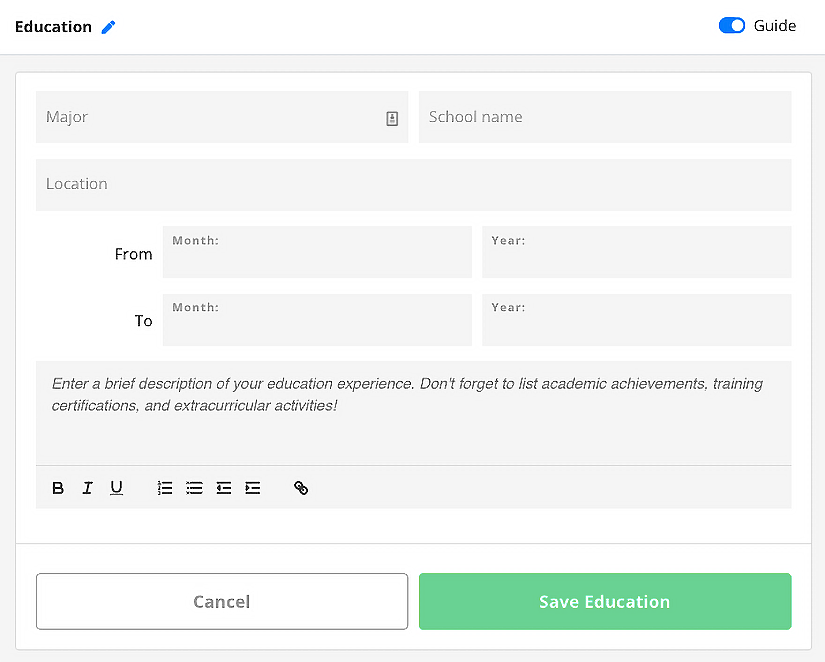
As you can see it’s just a matter of entering your data and you’re all set. The outcome looks like this:

8. Skills
Your skills are an essential part of your resume. Hiring managers will be on the lookout for certain skill sets and it is your job to show that you have the skills they need.
Keep in mind though, that there are some different ways to add them depending on what resume format you’ve chosen. Their role also changes depending on where in your career you are at the moment. Let’s take a closer look.
A great way of adding your most relevant skills to your resume is to showcase them in your summary and in your work experience. And of course you should also add your most valuable skills in the skills section. This goes particularly for any technical skills or software skills you may have.
When we talk about skills we differentiate between soft skills and hard skills.
Your hard skills are the quantifiable, job-specific abilities that you learn through education, training or through your work experience. Language skills, computer skills and being able to handle heavy machinery are all examples of industry specific hard skills.
Soft skills, or interpersonal skills as well, on the other hand, are the skills that are a part of your personality. They are the personal characteristics that positively influence how you work and interact with other people. These skills are not easily taught in a classroom. Skills such as verbal and non-verbal communication, problem solving and critical thinking are all examples of soft skills that are highly valued by most employers.
9. Optional: Relevant additional sections
This part of your resume is optional and should only be added if it’s relevant to the position. An additional section could be volunteering, if you can show how it’s beneficial to the company that’s hiring. This will show that you’re a dedicated person and employers love that. Other examples of relevant extra sections for your resume include projects, certificates, hobbies, or internships.
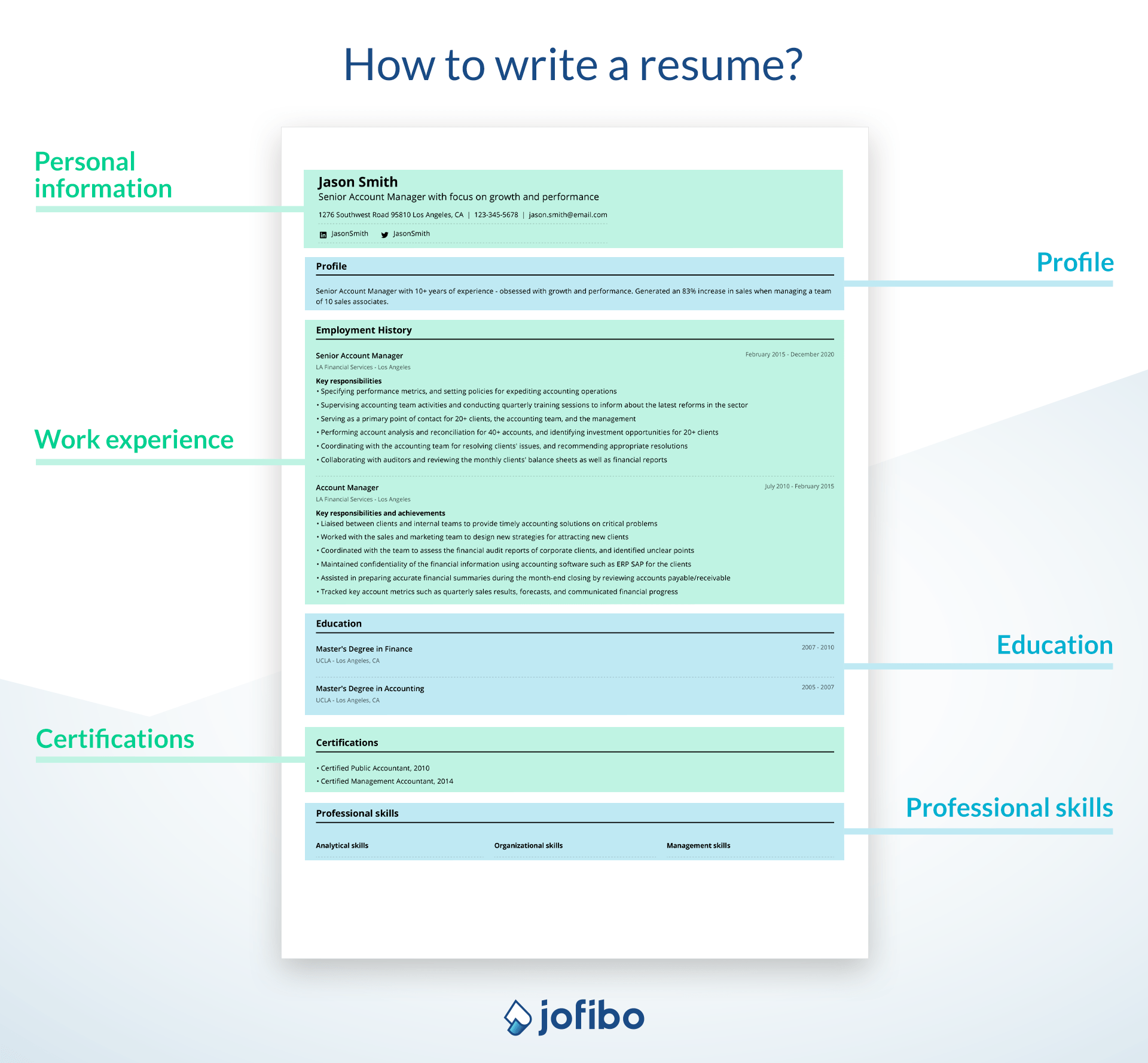
10. Proofread
The last step before submitting your resume and other application documents is to proofread. Always proofread your work a little while after you’ve written it. What sounded great while you wrote it, might not sound as great later in the day or even the day after.
When you write resumes for different job positions (and of course you always tailor your resume to the relevant job position) it is so easy to accidentally write the wrong company name or make another embarrassing mistake. Don’t be that person.
Also, it’s a good idea to get a second pair of eyes to look over your resume. So hand it over to your spouse, a family member, or a friend to let them give it a run-through. If something is unclear to them it’s a good indication that you need to make some adjustments.
4 great advice for your resume
If you’ve ever asked yourself “How to write a good resume?” I hope this article has helped you. As a small bonus we’ve found four additional pieces of advice for your resume. They will make you appear confident, competent, and professional.
First of all, where do you think the recruiter gets their very first impression of you? In the email you send along with your resume and cover letter. It has to be on point.
Make sure:
- You use the recruiter’s name (just like in your cover letter)
- It’s well written and without grammatical errors or typos
- You remember to attach your documents (this is a classic error so double check before hitting that send-button)
- You finish with a call to action where you let the recruiter know that you are available on email and phone for any further questions
As you can see there are a lot of dos and don’ts when it comes to how to write a resume. To make it easier for you to learn how to write a resume, we’ve made a list. We hope this will help you navigate the resume-jungle.
Dos and don’ts when writing your resume
Do
- Use power words such as “achieve”, “manage”, “resolve”, “launch” (in moderation)
- Quantify your achievements (“grew revenue with 57% during first year of employment”)
- Include relevant previous jobs since the past 15 years
- Use a resume template that will present your resume in an ordered and pleasing-to-the-eye manner
- Include your name and contact information
- Include your latest educational degree, relevant certificates, and diplomas
Don’t
- Use worn out terms like “go-getter”, “think outside the box”, “synergy”
- Describe your achievements generically (“was responsible for a much higher revenue during first year of employment”)
- Include all previous jobs since you had that news paper route
- Shift between fonts, use up all the white space, or change between date formats
- Include sensitive personal information like social security number
- Include all education since elementary school
